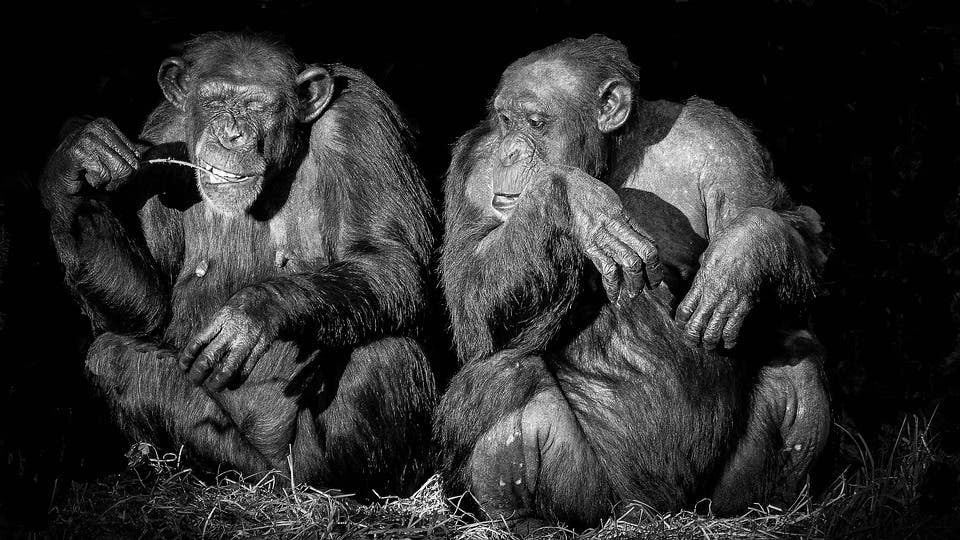Despite sometimes engaging in some pretty gross behavior, chimps don’t like yicky things either, a new paper reveals. The findings offer a glimpse into the roots of our own sense of disgust.

Chimps aren’t the best-mannered animals out there. In the wild, they have been observed to pick out seeds from feces and eat them. In captivity, some have been spotted engaging in coprophagy — the deliberate ingestion of feces. All of which we’d definitely characterize as being downright disgusting behavior.
Banan-eeewww!
But that doesn’t mean they don’t feel disgusted at all. The behaviors we’ve mentioned above usually involve each chimps’ own feces, or at most that of their immediate family members. If presented with bodily fluids or feces from other chimps, however, they will exhibit behaviors very suggestive of disgust. In theory, animals evolved this aversion to protect themselves from parasites and pathogens. In humans, bodily products are a universal elicitor of disgust, and the paper found evidence that exposure to biological contaminants — via vision, smell, or touch — also elicit similar reactions in chimpanzees by influencing feeding choices.
“If chimpanzees and other primates can discern contamination risk via different cues, individuals with higher sensitivities to feces and other bodily fluids may be less infected, which could have important health benefits,” explains Cecile Sarabian, the lead author of the study.
The team worked with 20 chimpanzees (Pan troglodytes troglodytes) at the Centre International de Recherches Médicales de Franceville (CIRMF) in southern Gabon. Throughout a series of experiments, the team was able to show that chimps will generally delay eating potentially contaminated food items.
First, the primates were presented with a choice of three bananas — one on a piece of brown foam (control sample), one placed on a replica pink feces, and one placed on a brown replica. The team reports that the chimps would first select the bananas atop the control foam and the pink feces replica significantly more often than the ones on the brown feces replica. This shows “a preference for food that is not associated with contamination risk” but not an “avoidance of such risk altogether,” as generally, they would still eat all three bananas.
The animals also showed a “weak tendency” of moving away from the smell of potential biological contaminants (conspecific feces, blood, and semen) compared to a control sample of water. Food trials revealed that the smell of blood or semen again had a limited effect on the chimps’ appetite compared to a control odor (they ate the bananas given to them 93%, respectively 92% of times, compared to 93% with control odor). Finally, they also tended to move away from and/or consume food items less often when associated with odors of these potential contaminants, the authors write. These tendencies were overall weak, the scientists add, suggesting that “the threat levels perceived [by the chimps] may not have been great.”
Icky fingers
For the third experiment, the team worked with 42 chimps. The primates were presented with a foraging task designed to put them into surprise tactile contact with two hidden substrates: dough, which has been used in human experiments to replicate the consistency, temperature, and moisture of a potentially contaminated substrate, or a piece of rope used as a control. Both substrates were hidden inside a box so the chimps couldn’t see them. What the chimps did see, however, was that the team placed pieces of banana in each box.
The chimps that received a box with rope substrate ate the banana pieces roughly 91% of the time. In contrast, their dough-boxed counterparts only ate the food 54% of the time. It’s the single most powerful disgust behavior elicited by the chimps in this study. The results are very similar to the behaviors shown by humans when blindly touching soft and moist substrates, which are generally more contaminant-rich than hard and dry substances.
“While anyone watching the reactions of these chimpanzees in the tactile experiments can empathize with them, it’s premature to say that they feel the same as we might in that situation” cautions Andrew MacIntosh, senior author on the study.
“What’s great about these experiments, though, is that the observed responses are functionally similar to what ours would be, providing evidence that the mechanism underlying their behavior could be similar to ours.”
The results help pave the way to understanding the disgust mechanism in humans and the protective function it serves.
“Moreover, such results may have implications for animal welfare and management. We can better inform staff and keepers about the adaptive value of such sensitivity and its flexibility, as well as identify which individuals may be more at risk of infection and therefore require more attention,” concludes Cecile Sarabian.
The team is now working on “expanding our ‘disgusting’ work” to other primate and non-primate species to get a more bird’s eye view of how the emotion forms and functions.
The paper “Avoidance of biological contaminants through sight, smell and touch in chimpanzees” has been published in the journal Royal Science Open Society.


